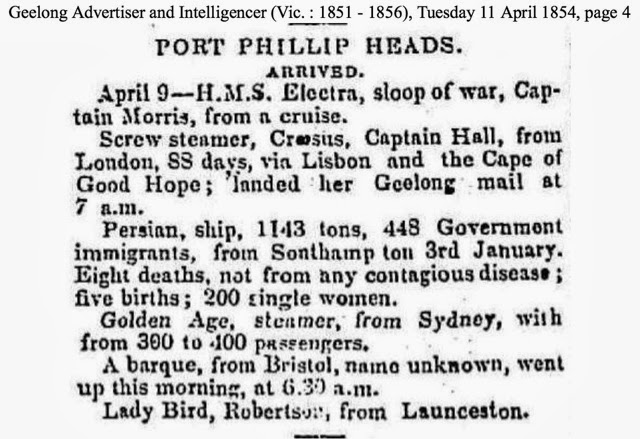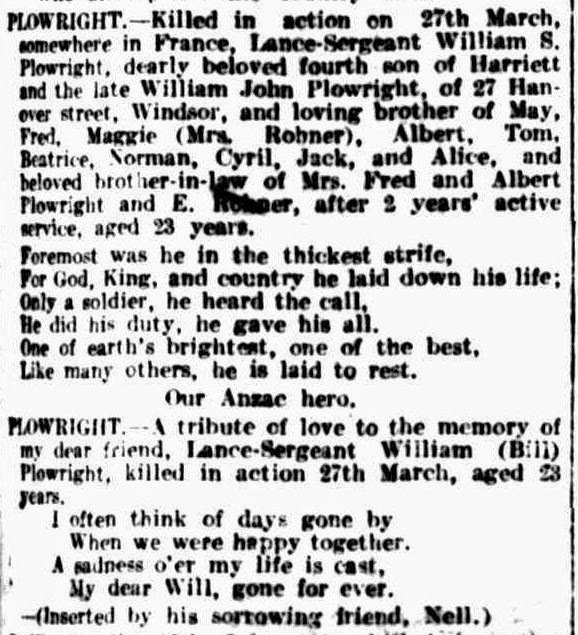Ann Jane Cross, my husband Greg’s great grandmother, was born on 30 August 1862 at Four Mile Flat—later named Homebush—near Avoca in central Victoria. She was the third of six children born to John and Margaret Plowright nee Smyth.
In April 1878 Ann’s brother Frederick died while cutting down a dead tree, which fell and crushed him. Ann witnessed the death and gave evidence at the inquest.

VPRS 24 1878/372 (male)
On 28 April 1886 Annie Plowright married Frederick James Cross at St. John’s Church in Avoca (mistakenly referred to as Christ Church in the newspaper announcement).
From the Age, 8 May 1886:
CROSS—PLOWRIGHT.— On the 28th April, at Christ Church, Avoca, by the Rev. J. A. Ball, Frederick J. Cross, eldest son of late J. Cross. Carnagham, to Annie, only daughter of John Plowright, of Homebush.
Frederick and Annie had ten children in 19 years; all survived to adulthood:
- James John (1887–1963)
- Annie Elizabeth (Ciss) (1888–1973)
- George Murray (1890–1962)
- Ellen Margaret (1891–1957)
- Frederick Beswick (1893–1959)
- William Bailey (1895–1955)
- Margaret Plowright (1897–1926)
- Elizabeth (1900–1949)
- Mary Isabel (1902–1989)
- John Percival (1905–1981)
Ann Jane Cross was registered to vote in 1903 in Homebush, in the electoral division of Laanecoorie, Victoria, Australia. Her occupation was ‘home duties’. Her husband Frederick James Cross was also enrolled to vote, with the occupation of miner. The Commonwealth Franchise Act 1902 had granted most Australian women and men the right to vote and to stand in Federal elections.
In 1911 Ann Jane and Frederick J Cross celebrated their silver wedding anniversary. From the Ballarat Star, Friday 28 April 1911, page 2:
SILVER WEDDING. CROSS—PLOWRIGHT. On the 28th April, 1886, at St. John's Church, Avoca, by the Rev. J. A. Ball, Frederick J., eldest son of the late James Cross, Snake Valley, to Ann Jane, only daughter of John Plowright, of Homebush, Avoca.
Around 1924 the Cross family moved from Homebush to Sebastopol, near Ballarat. Ann Jane does not appear on the Avoca electoral roll of 1924. Frederick James Cross is listed in the Sands Directory for 1923 in Homebush, but in the 1924 directory he is listed at Victoria Street, Sebastopol. On the 1926 roll, Annie Jane Cross, ‘Home Duties’ was listed on the elctoral roll for the Division of Ballaarat, subdivision of Sebastopol, at Fairview, Victoria Street, Sebastopol. Her husband Frederick James, and daughter Elizabeth Young were listed at the same address.
This photo of Ann Jane and F.J. Cross taken around 1925 shows them on the verandah of Fairview, on the corner of Grant and Victoria streets. The house still stands today.
Frederick James Cross died on 23 May 1929 of “Calculus in Bladder” after an illness of 3 years. He was buried at Carngham cemetery with other members of the Cross family.
In late 1929 Ann Jane, her daughter Elizabeth Young and grandson Peter Young moved to 419 Ascot Street, Ballarat.
Ann died on 19 November 1930 aged 68 at the Ballarat District Hospital of an infected foot, diabetic gangrene, and asthenia (generalised physical weakness). She was buried in Carngham cemetery with her husband.
Related posts
Wikitree:

















































